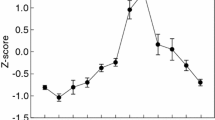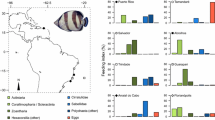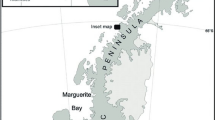Abstract
Estimates of daily feeding rates were obtained for two groups of herbivorous labroid fishes, one confined to cold water and the other to tropical reef environments. These were the family Odacidae, represented by Odax pullus from New Zealand waters, (Goat Island Bay: Latitude 36° South; on the northeastern coast of New Zealand) and the family Scaridae, represented by Scarus rivulatus, S. schlegeli and S. sordidus from the northern Great Barrier Reef (Lizard Island; a mid-shelf reef at 14° South latitude). Observations on the odacid were made in 1984 and in 1992, and on the scarids in 1984 and 1988. O. pullus displayed a diurnal feeding pattern in which the rates (expressed as bites min-1) are greatest early in the day. The mean combined feeding rate for three size groups (juveniles, subadults and adults) peaked (average of 2.9 bites) from 06.00 to 08.00 hrs and declined fourfold to a combined average of 0.7 bites min-1 by midday. The greatest mean feeding rate recorded was 3.7 bites min-1, with an overall mean of 1.8 bites min-1. For subadults and adults there were consistent trends in feeding, with subadults feeding at a greater rate than adults and both groups displaying a decline in feeding rate during the day. The change in feeding rate with time of day was statistically significant in both groups. The pattern for juvenile O. pullus was different from that in the two larger size groups in that juveniles did not show a uniform decline in feeding with time of day. For scarids, the daily feeding rate varied by site, but the pattern was similar for all species, characterised by initial low rates increasing to higher but variable levels by midday. The influence of both site of feeding and time of day on feeding rate was confirmed by analysis. The overall mean values for each species were 20.1 bites min-1 for S. rivulatus, 19.7 bites min-1 for S. schlegeli and 14.9 bites min-1 for S. sordidus. For scarids, the peak feeding rates varied from 19.3 to 32.8 bites min-1, with overall rates from 14.9 to 21.1 bites min-1. Estimates of activity and movement patterns during feeding were obtained for O. pullus. Distance moved per unit time was highly variable, 0.1 to 47.5 m min-1, with a mean of 8.5 m min-1 (SD=9.9). Trends in movement among sexes and size classes were obscured by the variable movement patterns of individual fishes.
Similar content being viewed by others
Literature cited
Andrew, N. L., Jones, G. P. (1990). Patch formation by herbivorous fish in a temperature Australian kelp forest. Oecologia 85: 57–68
Ayling, A. M., Cumming, A., Ballantine, W. J. (1981). Map of shore and subtidal habitats of Cape Rodney to Okakari Point Marine Reserve, North Island, New Zealand in three sheets, scale 1:2000. Department of Lands and Survey, Wellington, New Zealand
Bellwood, D. R., Choat, J. H. (1990). A functional analysis of grazing in parrotfishes (family Scaridae): the ecological implications. Envir. Biol. Fish. 28: 189–214
Choat, J. H., Ayling, A. M. (1987). The relationship between habitat structure and fish faunas on New Zealand reefs. J. exp. mar. Biol. Ecol. 110: 257–284
Choat, J. H., Bellwood, D. R. (1985). Interactions amongst herbivorous fishes on a coral reef: influence of spatial variation. Mar. Biol. 89: 221–234
Choat, J. H., Clements, K. D. (1993). Diet in odacid and aplodactylid fishes from Australia and New Zealand. Aust. J. mar. Freshwat. Res. (in press)
Choat, J. H., Schiel, D. R. (1982). Patterns of distribution and abundance of large brown algae and invertebrate herbivores in subtidal regions of northern New Zealand. J. exp. mar. Biol. Ecol. 60: 129–162
Clements, K. D. (1985). Feeding in two New Zealand herbivorous fish, the butterfish Odax pullus and the marblefish Aplodactylus arctidens. MSc thesis. University of Auckland, New Zealand
Clements, K. D. (1991). The endosymbiotic communities of two herbivorous labroid fishes, Odax cyanomelas and O. pullus. Mar. Biol. 109: 223–229
Clements, K. D., Bellwood, D. R. (1988). A comparison of the feeding mechanisms of two herbivorous labroid fishes, the temperate Odax pullus and the tropical Scarus rubroviolaceus. Aust. J. mar. Freshwat. Res. 39: 87–107
Clements, K. D., Choat, J. H. (1993). Influence of season, ontogeny and tide on the temperate marine herbivorous fish Odax pullus (Odacidae). Mar. Biol. 117: 213–220
Horn, M. H. (1989). Biology of marine herbivorous fishes. Oceanogr. mar. Biol. A. Rev. 27: 167–272
Horn, M. H., Messer, K. S. (1992). Fish guts as chemical reactors: a model of the alimentary canals of marine herbivorous fishes. Mar. Biol. 113: 527–535
Horn, M. H., Murray, S. N., Edwards, T. N. (1982). Dietary selectivity in the field and food preferences in the laboratory for two herbivorous fishes (Cebidichthys violaceus and Xiphister mucosus) from a temperate intertidal zone. Mar. Biol. 67: 237–246
Horn, M. H., Murray, S. N., Fris, M. B., Irelan, C. D. (1990). Diurnal feeding periodicity of an herbivorous blenniid fish, Parablennius sanguinolentus, in the western Mediterranean. Proc. 24th Eur mar. Biol. Symp. 170–182 [Barnes, M., Gibson, R. N. (eds.) University of Aberdeen Press, Aberdeen]
Horn, M. H., Neighbors, M. A., Murray, S. N. (1986). Herbivore responses to a seasonally fluctuating food supply: growth potential of two temperate intertidal fishes based on protein and energy assimilated from their macroalgal diets. J. exp. mar. Biol. Ecol. 103: 217–234
Lobel, P. S., Ogden, J. C. (1981). Foraging by the herbivorous parrotfish Sparisoma radians. Mar. Biol. 64: 173–183
Meekan, M. G. (1986). The distribution and abundance of the herbivorous fish Odax pullus and its influence on its food plant Eckloia radiata within a temperate marine environment. MSc thesis. University of Auckland, New Zealand
Polunin, N. V. C., Klumpp, D. W. (1989). Ecological correlates of foraging periodicity in herbivorous reef fishes in the Coral Sea. J. exp. mar. Biol. Ecol. 126: 1–20
Ralston, S. L., Horn, M. H. (1986). High tide movements of the temperate-zone herbivorous fish Cebidichthys violaceus (Girard) as determined by ultrasonic telemetry. J. exp. mar. Biol. Ecol. 98: 35–50
Randall, J. E. (1961). A contribution to the biology of the convict surgeonfish of the Hawaiian Islands, Acanthurus triostegus sandvicensis. Pacif. Sci. 15: 215–272
Rimmer, D. W., Wiebe, W. J. (1987). Fermentive microbial digestion in herbivorous fishes. J Fish Biol. 31: 229–236
Robertson, D. R. (1984). Cohabitation of competing territorial damselfishes on a Caribbean coral reef. Ecology 65: 1121–1135
Russell, B. C. (1983). The food and feeding habits of rocky reef fish of north-eastern New Zealand. N.Z. Jl mar. Freshwat. Res. 17: 121–145
Smith, R. L., Paulsen, A. C. (1974). Food transit times and gut pH in two Pacific parrotfishes. Copeia 1974: 796–799
Taborsky, M., Limberger, D. (1980). The activity rhythum of Blennius sangiunolentus Pallas, an adaptation to its food source? Pubbl. Staz. zool. Napoli (I: Mar. Ecol.) 1: 143–153
Zoufal, R., Taborsky, M. (1991). Fish foraging periodicity correlates with daily changes of diet quality. Mar. Biol. 108: 193–196
Author information
Authors and Affiliations
Additional information
Communicated by G. F. Humphrey, Sydney
Rights and permissions
About this article
Cite this article
Choat, J.H., Clements, K.D. Daily feeding rates in herbivorous labroid fishes. Marine Biology 117, 205–211 (1993). https://doi.org/10.1007/BF00345664
Received:
Accepted:
Issue Date:
DOI: https://doi.org/10.1007/BF00345664




